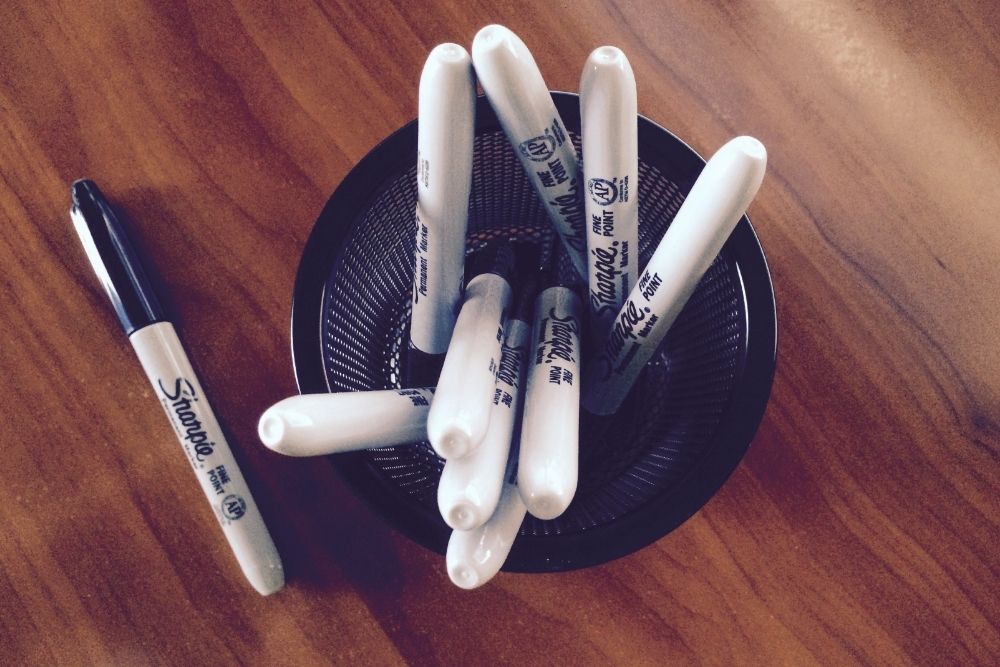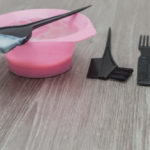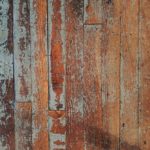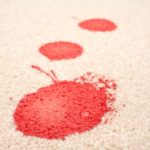We’ve all had a moment of despair when discovering that our permanent marker has bled through onto our wooden desk and whilst a permanent marker can severely damage some surfaces like marble or certain fabrics, it can easily be removed from the majority of wooden surfaces with just a tiny bit of patience and some much needed elbow grease.

You will also have the vast majority of the following DIY treatments in your home and so there is no need to invest money in restocking your household for this eventuality.
Methods Of Removing Sharpie

Rubbing Alcohol
Regularly rubbing alcohol into your wooden surface has proven to be incredibly effective and this is also an affordable solution as the vast majority of people will have some form of spirit-based alcohol in their kitchen cabinets.
You should ideally use some isopropyl alcohol from a medicine cabinet and pour it directly onto a clean, dry, cotton cloth. Then, dab the alcohol onto the sharpie stain ensuring that you do not rub.
The marker stain will eventually begin to lift. Once it has lifted, wipe away any leftover residue with a slightly damp cloth and pat it dry.
This method may take a few rounds to remove the stain completely and you should immediately stop applying any alcohol if you notice any stain or cloth discoloration.
If you don’t have any isopropyl alcohol in your medicine cupboard then using vodka is a highly effective alternative for removing permanent marker stains.
Try to ensure that you are using plain vodka and avoiding flavored variations that may cause discoloration as the sugars in flavored vodka can make your situation far worse. Like the previous method, soak a clean cotton cloth in vodka and lightly dab it onto the stain itself.
You will then start to notice the marker lifting directly from the wooden surface onto your cloth.
Using Nail Polish Remover
This is a brilliant solution to removing sharpie stains as if acetone-based nail polish remover removes those uniquely stubborn gel-based manicures then it will definitely be able to take on your sharpie stain!
Take a clean, dry cloth and lightly dab your sharpie stain with an acetone-based nail polish remover. You should try to avoid rubbing the stain as this form of remover can actually damage wooden finishes.
Ideally, you should test this method in a spot that can’t be seen prior to actually using it on the surface of your wooden furnishings.
Using Hairspray
This is another product that can be taken directly from your dressing room and used to keep a lot more than just your hair in place. Hairspray is a useful tool for removing all manner of stains ranging from permanent marker stains on weed to pen ink stains on fabrics.
You should spray the stain on your wooden surface with a small amount of hairspray and then wide away any residue with a cloth. The stain should begin to lift immediately especially if you are using the hairspray straight after the stain has occurred.
Using Baking Soda
Baking soda can also be utilized as an effective stain remover as well as a handy household cleaner. You should form a paste using water and baking soda and then lightly rub it into the sharpie stain using specifically circular motions.
If you don’t have any baking soda in your household then using toothpaste can also have the same impact, however, gel toothpaste will not work.
Using Melamine Foam
This form is otherwise known as a Magic Eraser and for a good reason! Melamine foam can be utilized to remove permanent marker spots from finished wooden surfaces.
You should ensure that you only use this treatment for gentle spot treatments with light dabs on the stains surface as rubbing that surface too firmly can damage the finishing on the wood.
Using Dry-Erase Markers
If you’re feeling extra experimental and your wooden surface has been painted or stained with an opaque permanent marker then you should attempt to draw over the stain with a dry-erase marker.
After you have done this, wipe the marking away. Using another marker may seem counterintuitive but this can work wonders on finished wood surfaces. However, you should avoid using this method on unfinished wood.
Using Fine Grit Sandpaper
Using Fine Grit Sandpaper on unfinished woods will definitely lift a sharpie stain effectively. However, it shouldn’t be used on stained or finished wood as it will undoubtedly remove the finish as well as the stain or paint.
If your wood is unfinished, then this is definitely the best method to use as permanent markers can easily permeate into the grooves of unfinished wood. Thus, sanding a specific area with a fine grit will lightly remove the permanent marker stain by taking away minor layers of the wooden surface.
You should also avoid using this method too aggressively as you may wear an unwanted spot into the wooden surface. Larger strokes are more favorable when using this method.
To conclude, if you’re removing a sharpie stain from a wooden surface then you should be prepared to engage in several rounds of light cleaning with a clean, cotton cloth and you should always avoid scrubbing the stain with a rough sponge or brush as this will undoubtedly remove the wood’s finish and damage any wooden surface.
Be sure to test your solution of choice in a hidden spot like underneath a wooden desk in case it causes irreparable damage to the surface.
It is possible to prevent marker stains from leaving a permanent mark on your wooden surface but if you are tackling a tough stain and the techniques that I have listed above don’t do the trick, then leave it to a professional woodworker or furniture restoration service in your local area as opposed to becoming frustrated and aggressive in your approach to removing the sharpie stain.










